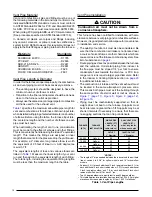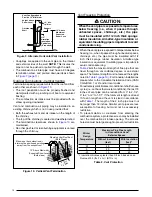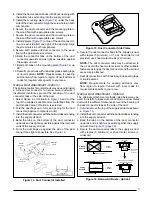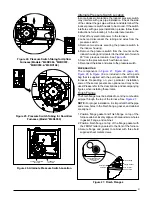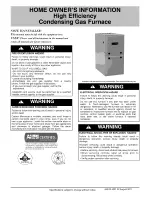
13
Existing Installations
When an existing furnace is removed from a vent system
serving other appliances, the existing vent system may
not be sized properly to vent the remaining appliances
(Example: water heater). An improperly sized venting
system can result in the formation of condensate, leakage,
or spillage. The existing vent system should be checked
to make sure it is in compliance with NFGC, ANSI Z223.1,
or CAN/CGA B149 and must be brought into compliance
before installing the furnace.
NOTE: If replacing an existing furnace, it is possible you
will encounter an existing plastic venting system that is
subject to a Consumer Product Safety Commission recall.
The pipes involved in the recall are High Temperature
Plastic Vent (HTPV).
If your venting system contains
these pipes
DO NOT reuse this venting system!
This
recall does not apply to other plastic vent pipes, such
as white PVC or CPVC. Check for details on the CPSC
website or call their toll-free number (800) 758-3688.
Concentric Vent Termination
A concentric vent termination (kit # 904953) is approved
for use with these furnaces. Please follow the installation
instructions provided with the kit for proper installation.
Condensate Disposal
The method for disposing of condensate varies according
to local codes. Consult your local code or authority having
jurisdiction. Neutralizer kit P/N 902377 is available for
use with this furnace.
Please follow the instructions
provided with the kit.
This furnace has multiple options for positioning the vent
pipe as described in the Inducer & Venting Options section
(
). Each of the condensate drain lines must be
J-trapped using field supplied parts.
After the condensate lines are J-trapped, they may be
combined together when routed to the drain. Avoid areas
where condensate drainage may cause problems by
dropping onto planters, patios, etc.
NOTE: Industry research studies indicate that when
condensate is routed to an active drain, household
detergents, etc., buffer its acidity. If the drain is not actively
used or if codes require, obtain a neutralizer kit (usually
contains limestone). Proper drains and connections to the
condensate tubing are required as NORDYNE cannot be
held responsible for water leakage which occurs due to
loose hose connections or improperly sealed drain line
pipes.
CIRCULATING AIR REQUIREMENTS
WARNING:
Do not allow combustion products to enter the
circulating air supply. Failure to prevent the
circulation of combustion products into the
living space can create potentially hazardous
conditions including carbon monoxide
poisoning that could result in personal injury
or death.
All return ductwork must be secured to
the furnace with sheet metal screws. For
installations in confined spaces, all return
ductwork must be adequately sealed. When
return air is provided through the bottom of the
furnace, the joint between the furnace and the
return air plenum must be air tight.
The surface that the furnace is mounted on must
provide sound physical support of the furnace
with no gaps, cracks or sagging between the
furnace and the floor or platform.
Return air and circulating air ductwork must
not be connected to any other heat producing
device such as a fireplace insert, stove, etc. This
may result in fire, explosion, carbon monoxide
poisoning, personal injury, or property damage.
Plenums & Air Ducts
• Plenums and air ducts must be installed in accordance
with the Standard for the Installation of Air Conditioning
and Ventilating Systems (NFPA No. 90A) or the
Standard for the Installation of Warm Air Heating and
Air Conditioning Systems (NFPA No. 90B).
•
and temperature rise data for each furnace input rate.
NOTE: If the maximum airflow is 1,600 CFM or more,
it is recommended that two openings be used for return
air on upflow furnaces. Downflow furnaces can only use
one return opening.
• It is recommended that the outlet duct contain a
removable access panel. The opening should be
accessible when the furnace is installed in service and
shall be of a size that smoke or refelcted light may be
observed inside the casing to indicate the presence of
leaks in the heat exchanger. The cover for the opening
shall be attached in such a manner as to prevent leaks.
• If outside air is used as return air to the furnace for
ventilation or to improve indoor air quality, the system
must be designed so that the return air is not less than
60° F (15° C) during operation. If a combination of indoor
and outdoor air is used, the ducts and damper system
must be designed so that the return air supply to the
Содержание M4RC-072D-35C
Страница 47: ...47...










